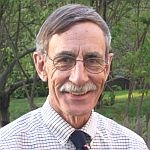 (Host) Even in this sesquecentennial year of the Battle of Gettysburg,
(Host) Even in this sesquecentennial year of the Battle of Gettysburg,
Commentator Bill Mares recently found that you can beat the crowds if
you get there early and are fleet of foot.
(Mares) There are
several advantages to sight-seeing in running shoes. It’s faster than
walking, not as noisy as a car, less cumbersome than a bike and less
crowded than a bus.
A few weeks ago, at 6 a.m. with morning
light just beginning to reflect off the film of overnight snow, I had
the whole battlefield of Gettysburg to myself. Well, I did share it with
about 160,000 ghosts and my imagination, as I trotted across hillock
and hollow, ditch and field and past some of the more than 1300
monuments and statues that cover those 15 square miles of hallowed
ground.
I began my run east of town where now-silent cannon
still face Culp’s Hill. I headed south toward Little Round Top, where I
huffed up to its rocky promontory. Next to the statue of Gen. Gouverneur
Kemble Warren I could see why he quickly sized up the importance of
this anchor for the whole Union force and quickly called for
reinforcements. Some of those forces were under Joshua Chamberlain who
charged downhill in a surprise bayonet attack that routed the rebels.
Plunging through thicket and brambles, I too joined the charge.
Across
the Valley of Death I made my way into the pile of trailer-sized rocks
known as Devil’s Den. I paused at the famous sniper nest where
photographer Alexander Gardner had dragged a dead rebel soldier and
labeled the resulting image "Death of a Confederate Sharpshooter."
A
quarter mile away I came upon a statue to Gen.(then Major) William
Wells of the Vermont Cavalry. It’s identical to the statue in
Burlington’s Battery Park, except that his sword is intact at
Gettysburg. Then I wove along the peaceful Wheat Field, which changed
hands six times in savage fighting on the battle’s second day leaving
4,000 dead and wounded.
I made my way to Seminary Ridge where
Robert E. Lee, having exhausted troops on the two flanks, gambled that a
frontal attack would break the Union center. As the light rose in the
East, I trotted onto the wide field where this courageous but suicidal
attack occurred and was reminded of the Tennyson lines from the Charge
of the Light Brigade: "Cannons to the right of them, cannons to the left
of them, Volleyed and thundered."
I headed for the tall spire
of the Vermont monument crowned by the one armed Gen. George Stannard.
Here, on Pickett’s right, in the words of the New York Times "A Vermont
brigade held the key position at Gettysburg and did more than any other
body of men to gain the triumph which decided the fate of the Union."
From
this "high water mark of the Confederacy, I trotted over to the
Soldiers Cemetery where President Lincoln delivered his immortal 272
words. I pulled a copy of the Address from my jacket pocket, and in a
biting north wind that still spat snow I read to myself that now-sacred
text. As I came to the end, I shivered, but not from the cold.